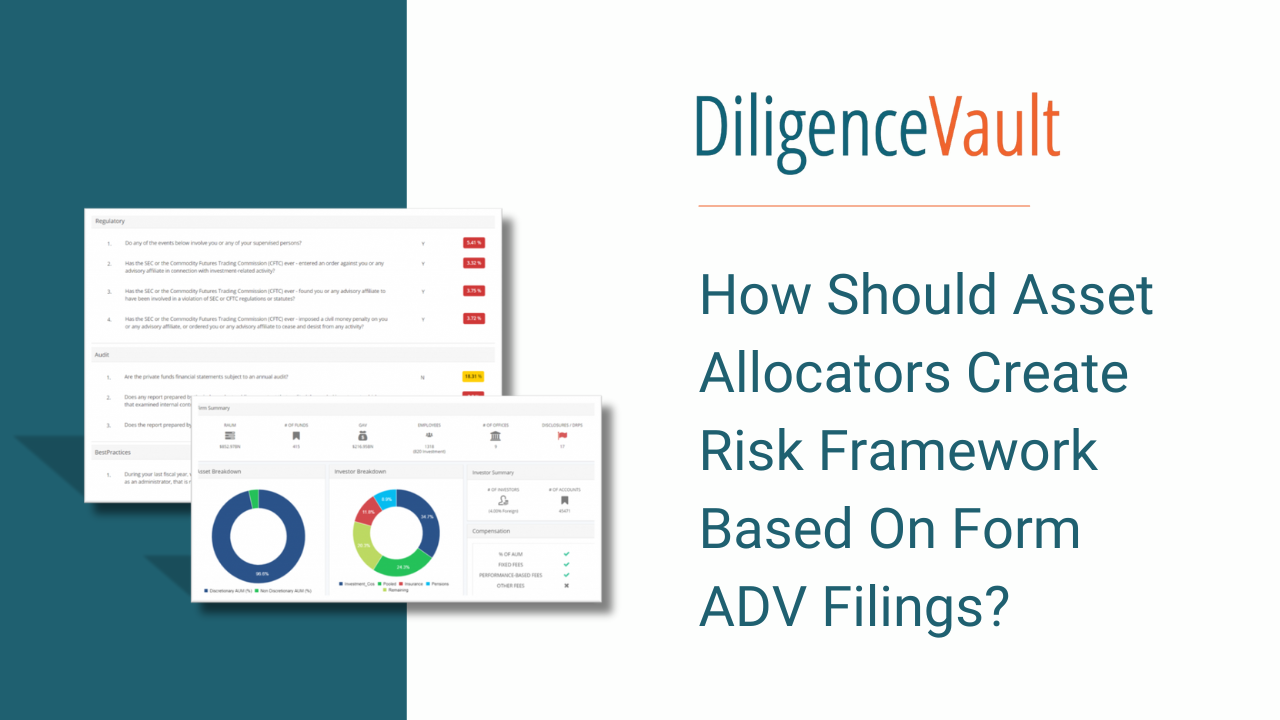Form ADV is a pivotal regulatory document required by the U.S. Securities and Exchange Commission (SEC) under the Investment Advisers Act of 1940. For asset allocators it serves as a critical disclosure document, offering detailed insights into the operations and risk factors of investment advisors. This rich Form ADV dataset can significantly enhance decision-making processes, risk management, and due diligence efforts.
Which Investment Advisors File Form ADV Filing?
Form ADV must be filed by all investment advisors who are registered with the SEC. This includes firms managing private funds, hedge funds, mutual funds, and other pooled investment vehicles.
What Is the Frequency Of Filing?
Investment advisors are required to file Form ADV at least annually, and within 90 days of their fiscal year end. Bulk of the investment advisors file by March 31st as 94% of the firms have their fiscal year ending in December.
In addition, investment advisors must also update their Form ADV promptly whenever there are significant changes to their business operations or practices, or to correct for a filing error. In the past year, nearly 1% of firms filed more than 10 times, 7% firms filed at least 5 times, and 43% at least twice. The higher frequency of filing can be a result of a firm changing rapidly or struggling with operational errors. And given several firms have stale filings, and the general frequency of filing, it’s important for asset allocators to keep on top of the filings as part of their monitoring program.
Another important risk consideration is late filers or stale filings. 30% of all filers have stale filing.
Fun Facts About Form ADV Filings
- Number of Firms Filing Annually: Over 25,000
- Number of Private Funds Reported: Over 100,000
- Number of Service Providers Involved: Over 200,000 relationships with fund administrators, prime brokers, auditors, custodians, and 3rd party marketers
- Total Filings Per Year: Over 45,000
What Are the Components Of The Form ADV Filing?
Part 1A: General Information – part provides detailed information about the advisor’s business operations, ownership, clients, employees, business practices, affiliations, and any disciplinary events.
Schedule D provides additional details on certain items in Part 1A, including information about private funds managed by the advisor, other business activities, and financial industry affiliations.
Part 1B: State-Registered Advisers – is completed by advisors who are registering with state securities authorities rather than the SEC.
Part 2A: Firm Brochure is a narrative document that provides detailed information about the advisor’s material changes, services, conflicts of interests, fees, and business practices.
Part 2B: Brochure Supplement provides information about the individuals who provide investment advice and interact with clients on behalf of the firm.
Part 3: Form CRS (Client Relationship Summary) provides a brief, plain-language overview of the advisor’s relationships and services.
Schedule R includes information about private fund client for advisors who are exempt reporting advisers (ERAs).
How To Identify Important Changes In Form ADV Filings?
Form ADV Part 1 includes questions designed to uncover potential regulatory, civil, or criminal issues, known as Disclosure Reporting Pages (DRPs). Asset allocators should monitor:
- New DRPs or Updates to DRPs: Any changes here can indicate emerging risks or issues
- Significant Headcount or RAUM Changes: Large shifts can signal instability or growth that requires further investigation
- Risk Flags: Changes in answers to risk-related questions can reveal new concerns
- New Fund Launches and Changes in Investor Types: These can indicate strategic shifts that may impact performance and risk
- Registration Changes: New registrations with foreign regulators or other changes can affect the advisor’s operations
- Service Provider Changes: Especially significant if there are changes in auditors or other critical service providers
- Fee Structure Changes: Adjustments in fee structures can impact the cost and value of investment
For a comprehensive view of potential risk flags and high impact changes using Part 1A filings, please refer to this whitepaper on Designing Asset Allocator Risk Framework Using Form ADV Filing Data.
Further Part 2B should also be reviewed to identify the following areas:
- Changes in Business Practices: Any significant changes can impact the risk profile or performance
- Updates to Fees and Compensation: Adjustments here can affect the cost-effectiveness of the investment
- Disclosure of Conflicts of Interest: New or updated disclosures can reveal potential areas of concern
- Disclosure of Other Risk Factors: Such as management and governance challenges, use of artificial intelligence and machine learning, and other such factors
In addition, asset allocators also find great use for this data set to source new managers as well as to create industry wide benchmarks:
How To Use Form ADV For Asset Manager Sourcing?
Investment teams at asset allocators are continuously looking for new asset manager launches, and new investment ideas. Form ADV filings serve as a good source of identifying advisers reaching new scale, as well as a source of market mapping. Below are three use cases:
- New Filers: Identifying new advisors entering the market with at least $25 million in assets can provide opportunities for early-stage investments or partnerships
- New Fund Launches: Monitoring new fund launches helps asset allocators stay informed about emerging investment opportunities and strategies
- New Sub-Advisory Relationships: Tracking new sub-advisory relationships can reveal shifts in strategy or new collaborations that may impact performance and risk
How To Use Form ADV For Industry Benchmarking?
Form ADV filings create a rich dataset of over 21 million records, which can be invaluable for benchmarking and identifying industry trends. Asset allocators can use this structured and normalized data to create new and differentiated analysis. Below are two examples that Team DiligenceVault recently leveraged.
- Overview of Secondary Funds to identify key players, and underlying asset classes
- Analyze “Skin in the Game” to determine the extent of investment advisors’ own capital in their funds, which can be a crucial indicator of commitment and alignment with investors
How To Leverage Form ADV For Service Provider Due Diligence?
Form ADV filings disclose detailed information about service provider relationships. Asset owners can:
- Normalize and Transform Data: Analyze service provider data to evaluate their strengths and business overviews
- Assess Service Provider Strengths: Understand the reliability and reputation of service providers based on their relationships with various advisors
Form ADV Filings – A Rich Dataset For Asset Allocators
By leveraging the comprehensive data and insights provided by Form ADV filings, asset allocators can enhance their due diligence processes, improve risk management, and make more informed investment decisions. Understanding the nuances and details of these filings is crucial for navigating the complex landscape of investment advisory services.
Here’s a whitepaper of 10 use cases for asset allocators. Join us in a discussion about how you leverage the ADV filings and what insights have you gained? Speak to our experts to learn more about how DiligenceVault’s Form ADV module helps with all of the above and much more!



